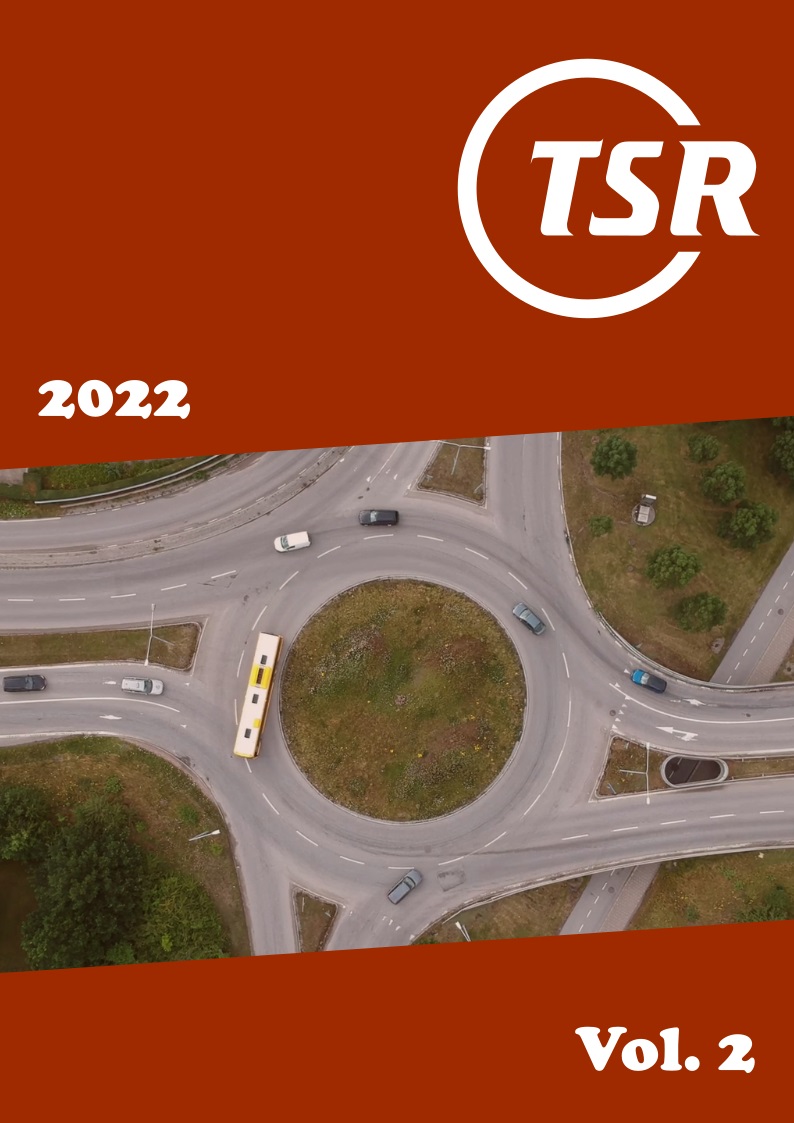Interact or counteract? Behavioural observation of interactions between vulnerable road users and autonomous shuttles in Oslo, Norway
DOI:
https://doi.org/10.55329/fbhr3456Keywords:
automated shuttles, autonomous vehicles, driverless shuttles, road user interactions, vulnerable road usersAbstract
The current paper presents the results of behavioural observations in a field experiment with automated shuttles in Oslo, Norway. Video observations were conducted at five fixed locations along a challenging 1.2 km automated shuttle line with varying traffic conditions. Observed interactions between vulnerable road users and automated shuttles were coded using a predefined codebook, which allowed a structured quantitative analysis. The paper identified several potentially risky types of situations in which the automated shuttles did not always behave according to the traffic rules. Generally, the automated shuttles failed to give way to pedestrians at pedestrian crossings in 26%–50% of the interactions. Right-turning shuttles failed to yield to cyclists going straight in 38% of the interactions at observation Site 1 (the only location where the automated shuttle takes a right turn). In majority of same direction interactions between cyclists and automated shuttles, the interactions resulted in the cyclist overtaking the automated shuttle, usually on the left-hand side. Generally, the paper found little evidence of road users trying to bully or otherwise take advantage of the defensive driving style of the automated shuttles and identified only a limited number of interactions in which a vulnerable road user behaved ignorant or aggressive towards the automated shuttles. In addition, the paper found very little indication of temporal effects that suggest changes in the interaction patterns over time.
Downloads
References
Ackermann, C., M. Beggiato, L.-F. Bluhm, et al. (2019), ‘Deceleration parameters and their applicability as informal communication signal between pedestrians and automated vehicles’, Transportation Research Part F: Traffic Psychology and Behaviour, 62, 757-768, https://doi.org/10.1016/j.trf.2019.03.006.
Ainsalu, J., V. Arffman, M. Bellone, et al. (2018), ‘State of the Art of Automated Buses’, Sustainability, 10 (9), 3118, https://dx.doi.org/10.3390/su10093118.
Antonialli, F. (2021), ‘Autonomous shuttles for collective transport: a worldwide benchmark’, International Journal of Automotive Technology and Management, 21 (1/2), 5, https://doi.org/10.1504/ijatm.2021.113349.
Bazilinskyy, P., T. Sakuma, J. de Winter (2021), ‘What driving style makes pedestrians think a passing vehicle is driving automatically?’, Applied Ergonomics, 95, 103428, https://doi.org/10.1016/j.apergo.2021.103428.
Beauchamp, É., N. Saunier, M.-S. Cloutier (2022), ‘Study of automated shuttle interactions in city traffic using surrogate measures of safety’, Transportation Research Part C: Emerging Technologies, 135, 103465, https://doi.org/10.1016/j.trc.2021.103465.
Berge, S. H., M. Hagenzieker, H. Farah, J. de Winter (2022), ‘Do cyclists need HMIs in future automated traffic? An interview study’, Transportation Research Part F: Traffic Psychology and Behaviour, 84, 33-52, https://doi.org/10.1016/j.trf.2021.11.013.
Bicchieri, C. (2005), The Grammar of Society: The Nature and Dynamics of Social Norms (Cambridge: Cambridge University Press), https://doi.org/10.1017/CBO9780511616037.
Björklund, G. M., L. Åberg (2005), ‘Driver behaviour in intersections: Formal and informal traffic rules’, Transportation Research Part F: Traffic Psychology and Behaviour, 8 (3), 239-253, https://doi.org/10.1016/j.trf.2005.04.006.
Bjørnskau, T. (2017), ‘The Zebra Crossing Game – Using game theory to explain a discrepancy between road user behaviour and traffic rules’, Safety Science, 92, 298-301, https://doi.org/10.1016/j.ssci.2015.10.007.
Bjørnskau, T., T. De Ceunynck, A. Fyhri, et al. (forthcoming), ‘Game over for AV shuttles? Are game theoretic predictions of ordinary road users’ interaction with AV shuttles supported by real-life experience?’, Transportation Research Interdisciplinary Perspectives (in review).
Björnstig, U., P.-O. Bylund, P. Albertsson, et al. (2005), ‘Injury Events Among Bus and Coach Occupants: Non-crash Injuries as Important as Crash Injuries’, IATSS Research, 29 (1), 79–87, https://doi.org/10.1016/S0386-1112(14)60121-7.
Camara, F., R. Romano, G. Markkula, et al. (2018), ‘Empirical game theory of pedestrian interaction for autonomous vehicles’, in Grant, R., T. Allen, A. Spink, M. Sullivan (eds.), Proceedings of Measuring Behavior 2018: 11th International Conference on Methods and Techniques in Behavioral Research, 6-8 June 2018, Manchester, UK (Manchester: Manchester Metropolitan University), 238-244, https://eprints.whiterose.ac.uk/129303, accessed 31 July 2022.
De Ceunynck, T., E. Polders, S. Daniels, et al. (2013), ‘Road Safety Differences between Priority-Controlled Intersections and Right-Hand Priority Intersections’, Transportation Research Record: Journal of the Transportation Research Board, 2365 (1), 39-48, https://doi.org/10.3141/2365-06.
De Ceunynck, T. (2017), ‘Defining and applying surrogate safety measures and behavioural indicators through site-based observations’, PhD thesis (double degree), Hasselt University, Belgium, and Lund University, Sweden, https://portal.research.lu.se/en/publications/7f7f7952-2b51-40ca-bb33-a551427ed6e8, accessed 31 July 2022.
Domeyer, J. E., J. D. Lee, H. Toyoda (2020), ‘Vehicle Automation–Other Road User Communication and Coordination: Theory and Mechanisms’, IEEE Access, 8, 19860-19872, https://doi.org/10.1109/access.2020.2969233.
Ezzati Amini, R., C. Katrakazas, A. Riener, C. Antoniou (2021), ‘Interaction of automated driving systems with pedestrians: challenges, current solutions, and recommendations for eHMIs’, Transport Reviews, 41 (6), 788-813, https://doi.org/10.1080/01441647.2021.1914771.
Fagnant, D. J., K. Kockelman (2015), ‘Preparing a nation for autonomous vehicles: opportunities, barriers and policy recommendations’, Transportation Research Part A: Policy and Practice, 77, 167-181, https://doi.org/10.1016/j.tra.2015.04.003.
Goffman, E. (2010), Relations in Public: Microstudies of the Public Order (New York: Routledge), https://doi.org/10.4324/9781315128337.
Goodall, N. J. (2021), ‘Comparison of automated vehicle struck-from-behind crash rates with national rates using naturalistic data’, Accident Analysis & Prevention, 154, 106056, https://doi.org/10.1016/j.aap.2021.106056.
Hagenzieker, M., R. Boersma, P. Nunez Velasco, et al. (2021), ‘Automated Buses in Europe: an Inventory of Pilots’ (Delft: Delft University of Technology), Version 1.0 ed., https://research.tudelft.nl/en/publications/automated-buses-in-europe-an-inventory-of-pilots-version-10, accessed 31 July 2022.
Hagenzieker, M. P., S. van der Kint, L. Vissers, et al. (2019), ‘Interactions between cyclists and automated vehicles: Results of a photo experiment’, Journal of Transportation Safety & Security, 12 (1), 94-115, https://doi.org/10.1080/19439962.2019.1591556.
Haque, A. M., C. Brakewood (2020), ‘A synthesis and comparison of American automated shuttle pilot projects’, Case Studies on Transport Policy, 8 (3), 928-937, https://doi.org/10.1016/j.cstp.2020.05.005.
Heikoop, D. D., J. P. Nuñez Velasco, R. Boersma, et al. (2020), ‘Automated bus systems in Europe: A systematic review of passenger experience and road user interaction’, Advances in Transport Policy and Planning, 5, 51-71, https://doi.org/10.1016/bs.atpp.2020.02.001.
Hydén, C. (1987), ‘The development of a method for traffic safety evaluation: The Swedish Traffic Conflicts Technique’, PhD thesis, Lund University, Sweden, https://www.ictct.net/wp-content/uploads/SMoS_Library/LIB_Hyden_1987.pdf, accessed 31 July 2022.
Johnsson, C., A. Laureshyn, T. De Ceunynck (2018), ‘In search of surrogate safety indicators for vulnerable road users: a review of surrogate safety indicators’, Transport Reviews, 38 (6), 765-785, https://doi.org/10.1080/01441647.2018.1442888.
Johnsson, C., T. De Ceunynck, B. Pelssers, et al. (forthcoming), ‘Behavioural observation of interactions between cars and autonomous shuttles in Oslo and Kongsberg, Norway’, Traffic Safety Research (in review).
Kassens-Noor, E., Z. Kotval-Karamchandani, M. Cai (2020), ‘Willingness to ride and perceptions of autonomous public transit’, Transportation Research Part A: Policy and Practice, 138, 92-104, https://doi.org/10.1016/j.tra.2020.05.010.
Kröyer, H. R. G., T. Jonsson, A. Várhelyi (2014), ‘Relative fatality risk curve to describe the effect of change in the impact speed on fatality risk of pedestrians struck by a motor vehicle’, Accident Analysis & Prevention, 62, 143-152, https://doi.org/10.1016/j.aap.2013.09.007.
Kyriakidis, M., J. C. F. de Winter, N. Stanton, et al. (2019), ‘A human factors perspective on automated driving’, Theoretical Issues in Ergonomics Science, 20 (3), 223-249, https://doi.org/10.1080/1463922x.2017.1293187.
Laureshyn, A. (2010), ‘Application of automated video analysis to road user behaviour’, PhD thesis, Lund University, Department of Technology and Society, Bulletin 253, https://lucris.lub.lu.se/ws/portalfiles/portal/5337337/1522970.pdf, accessed 31 July 2022.
Laureshyn, A., T. De Ceunynck, C. Karlsson, et al. (2017a), ‘In search of the severity dimension of traffic events: Extended Delta-V as a traffic conflict indicator’, Accident Analysis & Prevention, 98, 46-56, https://doi.org/10.1016/j.aap.2016.09.026.
Laureshyn, A., M. de Goede, N. Saunier, A. Fyhri (2017b), ‘Cross-comparison of three surrogate safety methods to diagnose cyclist safety problems at intersections in Norway’, Accident Analysis & Prevention, 105, 11-20, https://doi.org/10.1016/j.aap.2016.04.035.
Lee, Y. M., R. Madigan, O. Giles, et al. (2020), ‘Road users rarely use explicit communication when interacting in today’s traffic: implications for automated vehicles’, Cognition, Technology & Work, 23 (2), 367-380, https://doi.org/10.1007/s10111-020-00635-y.
Liu, P., Y. Du, L. Wang, J. Da Young (2020), ‘Ready to bully automated vehicles on public roads?’, Accident Analysis & Prevention, 137, 105457, https://doi.org/10.1016/j.aap.2020.105457.
Lubbe, N., Y. Wu, H. Jeppsson (2022), ‘Safe speeds: fatality and injury risks of pedestrians, cyclists, motorcyclists, and car drivers impacting the front of another passenger car as a function of closing speed and age’, Traffic Safety Research, 2, 000006, https://doi.org/10.55329/vfma7555.
Madigan, R., T. Louw, M. Wilbrink, et al. (2017), ‘What influences the decision to use automated public transport? Using UTAUT to understand public acceptance of automated road transport systems’, Transportation Research Part F: Traffic Psychology and Behaviour, 50, 55-64, https://doi.org/10.1016/j.trf.2017.07.007.
Madigan, R., S. Nordhoff, C. Fox, et al. (2019), ‘Understanding interactions between Automated Road Transport Systems and other road users: A video analysis’, Transportation Research Part F: Traffic Psychology and Behaviour, 66, 196-213, https://doi.org/10.1016/j.trf.2019.09.006.
Markkula, G., R. Madigan, D. Nathanael, et al. (2020), ‘Defining interactions: a conceptual framework for understanding interactive behaviour in human and automated road traffic’, Theoretical Issues in Ergonomics Science, 21 (6), 728-752, https://doi.org/10.1080/1463922x.2020.1736686.
Merat, N., T. Louw, R. Madigan, et al. (2018), ‘What externally presented information do VRUs require when interacting with fully Automated Road Transport Systems in shared space?’, Accident Analysis & Prevention, 118, 244-252, https://doi.org/10.1016/j.aap.2018.03.018.
Millard-Ball, A. (2018), ‘Pedestrians, Autonomous Vehicles, and Cities’, Journal of Planning Education and Research, 38 (1), 6-12, https://doi.org/10.1177/0739456x16675674.
Nordhoff, S., J. de Winter, R. Madigan, et al. (2018), ‘User acceptance of automated shuttles in Berlin-Schöneberg: A questionnaire study’, Transportation Research Part F: Traffic Psychology and Behaviour, 58, 843-854, https://doi.org/10.1016/j.trf.2018.06.024.
Nuñez Velasco, J. P., A. de Vries, H. Farah, et al. (2020), ‘Cyclists’ Crossing Intentions When Interacting with Automated Vehicles: A Virtual Reality Study’, Information, 12 (1), 7, https://doi.org/10.3390/info12010007.
Pelikan, H. R. M. (2021), ‘Why Autonomous Driving Is So Hard: The Social Dimension of Traffic’, presented at Companion of the 2021 ACM/IEEE International Conference on Human-Robot Interaction (Boulder, CO, USA: 8-11 March 2021), https://doi.org/10.1145/3434074.3447133.
Pokorny, P., B. Skender, T. Bjørnskau, M. P. Hagenzieker (2021), ‘Video observation of encounters between the automated shuttles and other traffic participants along an approach to right-hand priority T-intersection’, European Transport Research Review, 13 (1), https://doi.org/10.1186/s12544-021-00518-x.
Rahman, M. T., K. Dey, S. Das, M. Sherfinski (2021), ‘Sharing the road with autonomous vehicles: A qualitative analysis of the perceptions of pedestrians and bicyclists’, Transportation Research Part F: Traffic Psychology and Behaviour, 78, 433-445, https://doi.org/10.1016/j.trf.2021.03.008.
Rasouli, A., J. K. Tsotsos (2018), ‘Joint Attention in Driver-Pedestrian Interaction: from Theory to Practice’, arXiv, 1802.02522, https://doi.org/10.48550/arXiv.1802.02522.
Reason, J., A. Manstead, S. Stradling, et al. (1990), ‘Errors and violations on the roads: a real distinction?’, Ergonomics, 33 (10-11), 1315-1332, https://doi.org/10.1080/00140139008925335.
Rehrl, K., C. Zankl (2018), ‘Digibus©: results from the first self-driving shuttle trial on a public road in Austria’, European Transport Research Review, 10, 51, https://doi.org/10.1186/s12544-018-0326-4.
Rovira, E., A. C. McLaughlin, R. Pak, L. High (2019), ‘Looking for Age Differences in Self-Driving Vehicles: Examining the Effects of Automation Reliability, Driving Risk, and Physical Impairment on Trust’, Frontiers in Psychology, 10, 800, https://doi.org/10.3389/fpsyg.2019.00800.
Räsänen, M., H. Summala (2000), ‘Car Drivers' Adjustments to Cyclists at Roundabouts’, Transportation Human Factors, 2 (1), 1-17, https://doi.org/10.1207/sthf0201_1.
Saunier, N., T. Sayed (2007), ‘Automated Analysis of Road Safety with Video Data’, Transportation Research Record: Journal of the Transportation Research Board, 2019 (1), 57-64, https://doi.org/10.3141/2019-08.
Schelling, T. C. (1960), The Strategy of Conflict (Cambridge, MA: Harvard University Press).
Silvano, A. P., H. N. Koutsopoulos, X. Ma (2016), ‘Analysis of vehicle-bicycle interactions at unsignalized crossings: A probabilistic approach and application’, Accident Analysis & Prevention, 97, 38-48, https://doi.org/10.1016/j.aap.2016.08.016.
Sugden, R. (2005), The Economics of Rights, Co-operation and Welfare (London: Palgrave Macmillan), https://doi.org/10.1057/9780230536791.
Svensson, Å. (1998), ‘A method for analysing the traffic process in a safety perspective’, PhD thesis, Lund University, Department of Traffic Planning & Engineering, Bulletin 166, https://portal.research.lu.se/files/4456913/1653512.pdf, accessed 31 July 2022.
Thompson, J., G. J. M. Read, J. S. Wijnands, P. M. Salmon (2020), ‘The perils of perfect performance; considering the effects of introducing autonomous vehicles on rates of car vs cyclist conflict’, Ergonomics, 63 (8), 981-996, https://doi.org/10.1080/00140139.2020.1739326.
Vissers, L., S. van der Kint, I. van Schagen, M. Hagenzieker (2016), ‘Safe interaction between cyclists, pedestrians and automated vehicles. What do we know and what do we need to know?’ (The Hague: SWOV Institute for Road Safety Research), R-2016-16, https://swov.nl/sites/default/files/publicaties/rapport/r-2016-16.pdf, accessed 31 July 2022.
Vlakveld, W., S. van der Kint, M. P. Hagenzieker (2020), ‘Cyclists’ intentions to yield for automated cars at intersections when they have right of way: Results of an experiment using high-quality video animations’, Transportation Research Part F: Traffic Psychology and Behaviour, 71, 288-307, https://doi.org/10.1016/j.trf.2020.04.012.
Zubin, I., N. Van Oort, A. Van Binsbergen, B. Van Arem (2021), ‘Deployment Scenarios for First/Last-Mile Operations With Driverless Shuttles Based on Literature Review and Stakeholder Survey’, IEEE Open Journal of Intelligent Transportation Systems, 2, 322-337, https://doi.org/10.1109/ojits.2021.3106164.
Downloads
Published
How to Cite
Issue
Section
License
Copyright (c) 2022 Tim De Ceunynck, Brecht Pelssers, Torkel Bjørnskau, Ole Aasvik, Aslak Fyhri, Aliaksei Laureshyn, Carl Johnsson, Marjan Hagenzieker, Heike Martensen

This work is licensed under a Creative Commons Attribution 4.0 International License.
















